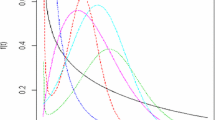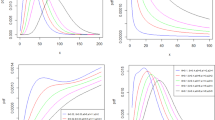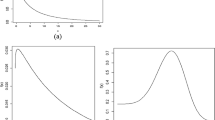Abstract
Bathtub shape is one of the most important behaviors of the hazard rate function that is quite common in lifetime data analysis. Such shapes are actually the combination of three different shapes and, as such, there have been several proposals to model such behavior. One such proposal is to combine at most three different distributions, often the Weibull or some similar model, separately for decreasing, constant, and increasing shapes of the hazard rate. Sometimes combination of two different models may also result in the required bathtub shape. The other proposal includes generalizing or modifying the two-parameter distribution by adding an extra parameter into it. It is often seen that the first proposal is quite cumbersome whereas the second fails to capture some important aspects of the data. The present work considers two recent generalizations/modifications of the two-parameter Weibull model, namely the Weibull extension and the modified Weibull models, and proposes mixing the two families separately with the three-parameter Weibull distribution in order to see if the mixing results in some real benefit though at the cost of too many parameters. The paper finally considers the complete Bayes analysis of the proposed models using Markov chain Monte Carlo simulation and compares them with both Weibull extension and the modified Weibull models in a Bayesian framework. It is observed that the mixture models offer drastic improvement over the individual models not only in terms of hazard rate but also in terms of overall performance. The results are illustrated with the help of a real data based example.




Similar content being viewed by others
References
Aarset, M.V. (1987). How to identify bathtub hazard rate. IEEE Trans. Reliab., R-36, 106–108.
Bebbington, M., Lai, C.D. and Zitikis, R. (2006). Changing phases of human life expectancy: can we find them mathematically? In Proceedings of the UNU–WIDER Conference on Advancing Health Equity. United Nations University–World Institute for Development Economics Research (UNU–WIDER), Helsinki, September.
Bebbington, M., Lai, C.D. and Zitikis, R. (2007a). Modeling human mortality using mixtures of bathtub shaped failure distributions. J. Theor. Biol., 245, 528–538.
Bebbington, M., Lai, C.D. and Zitikis, R. (2007b). A flexible Weibull extension. Reliab. Eng. Syst. Safety, 92, 719–726.
Bebbington, M., Lai, C.D. and Zitikis, R. (2008). Reduction in mean residual life in the presence of a constant competing risk. Appl. Stoch. Models Bus. Ind., 24, 51–63.
Berger, J.O. and Pericchi, L.R. (1996). The intrinsic Bayes factor for model selection and prediction. J. Am. Stat. Assoc., 91, 109–122.
Block, H. W. and Joe, H. (1997). Tail behavior of the failure rate functions of mixtures. Lifetime Data Anal., 3, 269–288.
Block, H.W. and Savits, T.H. (1997). Burn-in. Stat. Sci., 12, 1–19.
Block, H.W., Jong, Y.K. and Savits, T.H. (1999). Bathtub functions and burn-in. Probab. Eng. Inform. Sci., 13, 497–507.
Celeux, G. and Diebolt, J. (1992). A stochastic approximation type EM algorithm for the mixture problem. Stochastics and Stochastic Reports, 41, 119–134.
Dempster, A.P. (1974). The direct use of likelihood for significance testing. In Proc. Conference on foundational questions in Statistical inference. University of Aarhus, pp. 335–352.
Devroye, L. (1986). Non-uniform random variate generation. Springer-Verlag, New York.
Diebolt, J. and Robert, C.P. (1994). Estimation of finite mixture distributions through Bayesian sampling. J. R. Stat. Soc., Ser. B, 56, 363–375.
Dimitrakopoulou, T., Adamidis, K. and Loukas, S. (2007). A lifetime distribution with an upside-down bathtub-shaped hazard function. IEEE Trans. Reliab., 56, 308–311.
Geisser, S. and Eddy, W.F. (1979). A predictive approach to model selection. J. Am. Stat. Assoc., 74, 153–160.
Gelfand, A.E. (1996). Model determination using sampling based methods. In Markov Chain Monte Carlo in Practice, (W.R. Gilks, S. Richardson and D.J. Spiegelhalter, eds.). Chapman and Hall, London, pp. 145–161.
Gelfand, A.E. and Ghosh, S.K. (1998). Model choice: a minimum posterior predictive loss approach. Biometrika, 85, 1–11.
Ghosh, J.K. and Samanta, T. (2002). Non subjective Bayes testing – an overview. J. Stat. Plan. Inf., 103, 205–223.
Gilks, W.R. and Wild, P. (1992). Adaptive rejection sampling for Gibbs sampling. App. Stat., 41, 337–348.
Gupta, A., Mukherjee, B. and Upadhyay, S.K. (2008). Weibull extension model: a Bayes study using Markov chain Monte Carlo simulation. Reliab. Eng. Syst. Safety, 93, 1434–1443.
Gurvich, M.R., Dibenedetto, A.T. and Ranade, S.V. (1997). A new statistical distribution for characterizing the random strength of brittle materials. J. Mater. Sci., 32, 2559–2564.
Jaisingh, L.R., Dey, D.K. and Griffith, W.S. (1993). Properties of multivariate survival distribution generated by Weibull and inverse gamma mixtures. IEEE Trans. Reliab., 42, 618–622.
Jiang, R. and Murthy, D.N.P. (1999). The exponentiated Weibull family: a graphical approach. IEEE Trans. Reliab., 48, 68–72.
Krohn, C.A. (1969). Hazard versus renewal rate of electronic items. IEEE Trans. Reliab., R-18, 64–73.
Lai, C.D., Xie, M. and Murthy, D.N.P. (2003). A modified Weibull distribution. IEEE Trans. Reliab., 52, 33–37.
Laud, P.W. and Ibrahim, J.G. (1995). Predictive model selection. J. R. Stat. Soc., Ser. B, 57, 247–262.
Mann, N.R., Schafer, R.E. and Singpurwalla, N.D. (1974). Methods for statistical analysis of reliability and life data. John Wiley, New York.
Martz, H.F., and Waller, R.A. (1982). Bayesian reliability analysis. John Wiley, New York.
Mudholkar, G.S. and Hutson, A.D. (1996). The exponentiated Weibull family: some properties and a flood data application. Commun. Stat. - Theor. Meth., 25, 3059–3083.
Mudholkar, G.S. and Srivastava, D.K. (1993). Exponentiated Weibull family for analyzing bathtub failure rate data. IEEE Trans. Reliab., 42, 299–302.
Mudholkar, G.S, Srivastava, D.K. and Freimer, M. (1995). The exponentiated Weibull family – a reanalysis of the bus-motor-failure data. Technometrics, 37, 436–445.
Mudholkar, G.S, Srivastava, D.K. and Kollia, G.D. (1996). A Generalization of the Weibull distribution with application to the analysis of survival data. J. Am. Stat. Assoc., 91, 1575–1583.
Nadarajah, S. (2005). On the moments of the modified Weibull distribution. Reliab. Eng. Syst. Safety, 90, 114–117.
Patra, K. and Dey, D.K. (1999). A multivariate mixture of Weibull distribution in reliability models. Stat. Probab. Lett., 45, 225–235.
Sahu, S.K. and Dey, D.K. (2000). A comparison of frailty and other models for bivariate survival data. Lifetime Data Anal., 6, 207–228.
Spiegelhalter, D.J., Best, N.G., Carlin, B.P. and Vander Linde, A. (2002). Bayesian measures of model complexity and fit. J. R. Stat. Soc., Ser. B, 64, 583–639.
Tang, Y., Xie, M. and Goh, T.N. (2003). Statistical analysis of a Weibull extension model. Commun. Stat. - Theor. Meth., 32, 913–928.
Upadhyay, S.K. and Gupta, A. (2010). Bayesian analysis of modified Weibull distribution using Markov Chain Monte Carlo simulation. J. Stat. Comp. Simul., 80, 241–254.
Upadhyay, S.K. and Smith, A.F.M. (1994). Modeling complexities in reliability and the role of simulation in Bayesian computation. Int. J. Cont. Eng. Ed., 4, 93–104.
Upadhyay, S.K., Vasishta, N. and Smith, A.F.M. (2001). Bayes inference in life testing and reliability via Markov chain Monte Carlo simulation. Sankhya, Ser. A, 63, 15–40.
Vaupel, J.W. and Yashin A.I. (1985). Heterogeneity’s ruses: some surprising effects of selection on population dynamics. Am. Stat., 39, 176–184.
Wang, F.K. (2000). A new model with bathtub-shaped failure rate using an additive Burr XII distribution. Reliab. Eng. Syst. Safety, 70, 305–312.
Weibull, W. (1951). A statistical distribution function of wide applicability. J. Appl. Mech., 18, 293–297.
Wondmagegnehu, E.T., Navarro, J. and Hernandez, P.J. (2005). Bathtub shaped failure rates from mixtures: a practical point of view. IEEE Trans. Reliab., 54, 270–275.
Xie, M. and Lai, C.D. (1996). Reliability analysis using an additive Weibull model with bathtub-shaped failure rate function. Reliab. Eng. Syst. Safety, 52, 87–93.
Xie, M., Tang, Y. and Goh, T.N. (2002). A modified Weibull extension with bathtub-shaped failure rate function. Reliab. Eng. Syst. Safety, 76, 279–285.
Zhang, T.L. and Xie, M. (2007). Failure data analysis with extended Weibull distribution. Commun. Stat. Simul. Comput., 36, 579–592.
Acknowledgements
Research work of Ashutosh Gupta is financially supported by Council of Scientific and Industrial Research, New Delhi, India in the form of Senior Research Fellowship.
The authors wish to express their thankfulness to the Editor and anonymous referees of the Journal for improving the earlier version of the manuscript.
Author information
Authors and Affiliations
Corresponding author
Appendices
Appendix
Following algorithm was used to generate iteratively the parameter θ and the missing data z from π (θ ∣ x, z) and f (z∣x, θ), respectively.
Let \(\theta^0=\left( {\theta_1^{\left( 0 \right)} ,\theta_2^{\left( 0 \right)} \ldots\ldots \theta _{r}^{\left( 0 \right)}} \right)\) be the initial starting values in the iteration scheme then the algorithm at ‘t th’ step can be written as,
- (i):
-
generate z (t) ∼ f (z ∣ x, θ (t)).
- (ii):
-
generate θ (t + 1) ∼ π(θ ∣ x, z (t)).
where f(z ∣ x, θ (t)) is a multinomial distribution with weights given by \(\frac{p_j^{\left( t \right)} {f}_{j}^{\left({t} \right)} \left( {x_i} \right)}{\sum\limits_{l=1}^k {p_l^{\left( t \right)} {f}_{l}^{\left({t} \right)} \left( {x_i} \right)} }\), j = 1,2, . . . ,k, i = 1,2, . . . ,n, and π(θ|x, z) is used to denote the posterior of θ.
We have two mixture models, namely WEWM and MWWM, each having two components with mixing proportion p and 1 − p and, therefore, it would be more convenient to define z ij such that z i = z i1 and 1 − z i = z i2 for i = 1, 2,...,n. In this case f(z ∣ x, θ (t)) becomes simply binomial distribution with weights p ∗ and 1 − p ∗, where
Generation from π(θ ∣ x, z (t)) in step (ii) can be achieved using any of the MCMC procedures. To explore, let us write the full conditionals corresponding to each of the two mixture models so that the possibility of working in one dimension can be thought of. It is to be noted that if all the full conditionals are easily available where available is taken to mean that samples can be efficiently and straightforwardly generated, the generation from π (θ ∣ x, z (t)) reduces to simply Gibbs sampler implementation. In case a full conditional is difficult to run, one can apply Metropolis algorithm as a mixing strategy with the Gibbs sampler.
Full conditionals and generating algorithms for WEWM model
where \(\tau \le \mu \le \min \left\{ {A_x} \right\}=x_k \) (say). It can be seen that the full conditionals (A4) and (A5) are gamma distributions and any gamma generating routine can be used to generate variates from these (see Devroye, 1986). Generation from (A2) and (A3) is a bit complicated and no straightforward generation scheme appears applicable. We considered Metropolis algorithm with suitably centered and scaled univariate normal density as a candidate generating density for the Metropolis implementation (see, for example, Upadhyay, Vasishta and Smith, 2001). Full conditional (A6) is a log-concave density and adaptive rejection algorithm of Gilks and Wild (1992) can be successfully employed for generating from it. A(1) is a beta distribution and generation from it is quite routine.
Generation of μ can be achieved by using rejection sampling through specially designed envelop density for it. We used envelop density g(μ) as
Full conditionals and generating algorithms for MWWM model
where \(\tau \le \mu \mathrm{ } \le \min \left\{ {A_x} \right\}\). It is clear that full conditionals (B1), (B5), (B6) and (B7) are similar to (A1), (A5), (A6) and (A7) and, therefore, generation schemes for the corresponding variates remain the same. Full conditionals (B3) and (B4) can be shown to be log-concave and generation of corresponding variates can be done using adaptive rejection algorithm (see Gilks and Wild, 1992). Finally, (B2) is a gamma density and any standard gamma generating algorithm can be used to generate variates from this full conditional. We used a gamma generating routine given in Devroye (1986).
Rights and permissions
About this article
Cite this article
Upadhyay, S.K., Gupta, A. & Dey, D.K. Bayesian modeling of bathtub shaped hazard rate using various Weibull extensions and related issues of model selection. Sankhya B 74, 15–43 (2012). https://doi.org/10.1007/s13571-012-0041-4
Received:
Revised:
Published:
Issue Date:
DOI: https://doi.org/10.1007/s13571-012-0041-4




